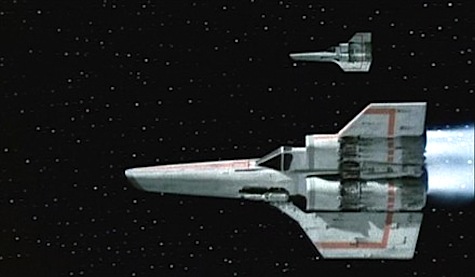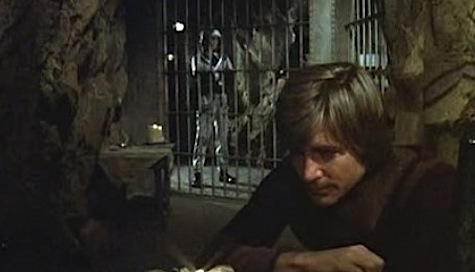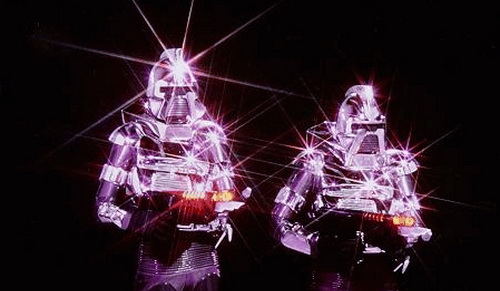There are Star Trek fans who have never seen the original series, and contemporary Doctor Who fans who somehow started with Matt Smith, but the most brutally discarded sci-fi parent of them all is easily the 1978 version of Battlestar Galatica. I’d assert sci-fans today are more likely to watch the lukewarm BSG spinoff Caprica than the original Battlestar Galatica. Which is a shame, because old school Battlestar was an ambitious and fantastic show that, despite its kitschy trappings, deserves a little more respect than it gets. Here’s why.
There’s no escaping how much the original version of Battlestar Galactica looks like Star Wars; from the red stripe painted on the fuselage of the Vipers, to the rag-tag worn-out look of the spaceships, to the feathery haircuts of Starbuck and Apollo, a small child or elderly parent in 1978 could have easily squinted at the television and believed this was Star Wars: The TV Show. And while the Colonial Warriors battled the robotic Cylons, 20th Century Fox sued Universal over a supposed 83 similarities between Star Wars and Battlestar. While it’s true Battlestar was firmly stuck in a quickly recognizable 1970’s sci-fi aesthetic, that fact is hardly its own fault! Industrial Light and Magic’s special effects pioneer John Dykstra created all the visuals for the Battlestar pilot movie, while Ralph McQuarrie contributed production paintings for concept art.

The project these guys had both worked on immediately previous to Battlestar was, of course, Star Wars. So, while leaving any George Lucas-bashing out of the conversation, claiming Battlestar as some kind of Star Wars mockbuster rip-off is fairly deranged. Yes, we’re dealing with humans who are potentially living in a galaxy far, far away fighting for their survival, but really, Battlestar’s conceptual core is way darker than Star Wars.
On paper, the show’s premise is totally hopeless. Robots descended from lizards completely destroy every single planet all the humans live on, forcing them to throw together a bunch of spaceships and go on the run. Battlestar begins its story by saying “we’ve lost!” And though the tone and the dialogue of the various characters is mercilessly upbeat and hokey, the Cylons are chasing them and genuinely trying to kill them. Battlestar may have tried to screw up its post-apocalyptic badassery with cutesy children, robot dogs, and shit-eating grins, but it still didn’t change the fact that the premise of the show was awesomely dark and complex. All of these themes would, of course, be mined for maximum gritty drama in the contemporary reimagined version of the show, but they’re still present here in the original. In short, the material is fantastically creative, even if the execution is all over the place.
And as killer robots go, nobody has ever looked the part more gloriously than the classic Cylons. They’re shiny silver, they walk slow, they have awesome robot voices, there’s a moving red light instead of eyes, they have catch phrases, and sometimes they have swords. What more do you want? The reason the Cylons are the near perfect platonic form of a “murdering robot” is because there’s something inherently silly about them. You’re not really afraid of the Cylons as a kid, but you know they need to be taken seriously, because despite having Imperial Stromptrooper bad aim, they did manage to shoot Jane Seymour before she really got a chance to fly more spaceships.
There are so many aspects to Battlestar which prove it to be influential to future sci-fi television: the long story-arcs (will they find Earth?) the giant cast (that opening credit sequence is crazy) and, sadly, the moments when it tends to jump the shark (Fred Astaire as Starbuck’s dad is fairly terrible.) But the real charm of Battlestar is its ability to do the swashbuckling space fantasy Star Wars thing, while still being a science fiction show, about thought-provoking ideas. I’m not saying Battlestar had an awesome “alien of the week” like Star Trek or Doctor Who, but instead occasionally told interesting human stories in a tricky science fiction way.

My favorite of these is called “The Long Patrol.” In it, hotshot pilot Starbuck (Dirk “The Face” Benedict) crash-lands on a prison planet populated by inmates serving time for crimes committed by their ancestors. Following this “logic,” the prisoners’ names are all related to their crime; Assault 9, Forger 7, and, of course, Adulteress 58. The best part comes when Adulteress 58 asks, “What kind of an offense is Starbuck-ing?” Starbuck tries to explain he’s not a criminal and actually a Colonial Warrior. Tragically, all these prisoners believe the war against the Cylons is still on, forcing Starbuck to reveal to them that humanity has totally lost and is on the run. Not convinced of his story, the inmates refer to him as an “original sinner,” assuming he is the first one of his family to have done something wrong. This idea of generations perpetually being born into crime is pretty hefty stuff, which classic Battlestar naturally tried to play down by having Starbuck crack jokes every three seconds and presenting all the characters as comically and constantly drunk.
And it’s in this tonal paradox where I am endlessly charmed by the old Battlestar Galatica. By all accounts, Ron Moore and David Eick did the right thing by taking the essential premise of the show, and spinning it realistic. But there’s something to be said about trying to create a family show, with a gee-wiz 70’s Star Wars vibe that is actually about extinction, hopelessness, poverty, hunger, and military ethics. Unlike its super-self conscience offspring, the original Battlestar Galatica didn’t artfully try to balance any of this, but instead presented it all casually, and oddly.
The old Battlestar was that smart person at the party, a little drunk, making a few misplaced jokes, but ultimately charming and original. And for that, those of you unaware of the show, should love it more than you do right now.
Ryan Britt is a staff writer for Tor.com.










